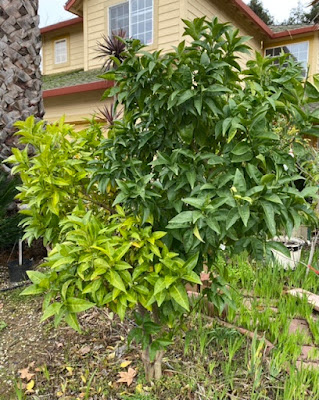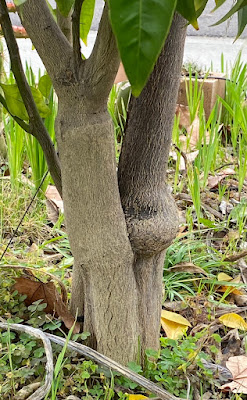As we select plants in nurseries, it is important to inspect the graft joint. This is the place where the scion meets rootstock. Unfortunately, even some commercially produced plants from reputable suppliers may have problems with the graft quality. The performance of such plants will suffer and they may be short lived. In the picture below is my Moro blood orange that I purchased years ago. This tree never grew well. A couple of years ago after noticing sprouts from the rootstock, I grafted the scions from this tree onto the sprouts. The green portion of the tree (on the right) is from my new graft, and the yellowish part is the original tree.
The lower bulbous joint is what the tree came with. There is some structural problem which affects (most likely) the vascular transport in this part of the plant. The higher graft (left) that I made, seems to be more solid structurally and its vascular system supports the flow of nutrients to keep this part of the tree green. In the coming spring, I will remove the original graft and will leave only my grafts to form this tree.Sunday, December 26, 2021
Graft quality matters
In this post I describe how to identify good and bad graft joint unions, and why joint quality matters.
Persimmon grafts seem to be very sensitive to infections, if not properly healed. Below is a joint on a two year old, commercially purchased persimmon tree. I do not think this tree can live for much longer. I will need to re-graft it on new rootstock.
An example of properly healed peach graft below:
An excellent avocado graft (2.5 years old), where the joint has almost disappeared:
The smother and the straighter the graft joint, the higher the chance that the tree will become a great performer.
When choosing trees at nurseries, we should pay attention to the graft joint and select the best one.
Subscribe to:
Post Comments (Atom)
Cuttings Sale in December 2025
This post describes the cuttings sale on reallygoodplants.com in December 2025. This year we are offering wood from 594 different cultivar...














Nice examples! Most commercial citrus is bad grafted, I wonder what went wrong.
ReplyDeleteI'd always thought that new growth would overcome any flaws in the graft, and I have no personal evidence that it won't. But your example is convincing. I once had a Santa Rosa plum with a bulge at the graft like that, and it never produced well. But down here in SoCal we expect plums not to get adequate winter chill, so that's what I attributed the poor production to. Too bad it didn't send up any root suckers!
ReplyDeleteJust noticed that a graft on my sapodilla is lumpy. I assumed it would smooth out. If it doesn't, I guess I'm in trouble. The question is, why do the bulges and lumps form? Are the scions incompatible in some way?
ReplyDeleteMost likely it's not due to a genetic incompatibility. It could be some early necrosis or trapped air that plant is trying to isolate/compensate by forming this callus tissue around. there is a paper on wine grapes that examines the grafts using X-Rays: https://www.infowine.com/intranet/libretti/0/20102-Spilmont.pdf
Delete